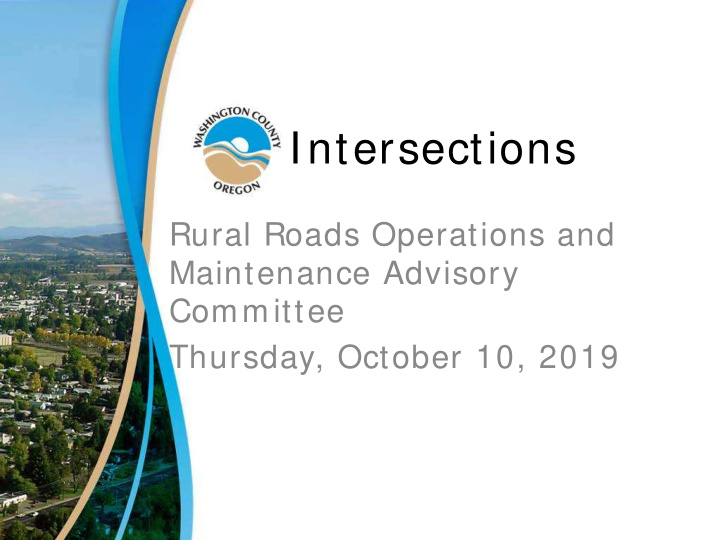



Intersections Rural Roads Operations and Maintenance Advisory Committee Thursday, October 10, 2019
Intersection Control Evaluation - Intersection traffic control study is completed when significant changes to an intersection are under consideration. - The purpose is to determine the most appropriate form of traffic control. 2
Intersection Control Evaluation - The study evaluates the alternatives and considers the benefits of each. - Considerations include: ‒ Safety performance ‒ Operational performance ‒ Environmental impacts ‒ Right-of-way impacts ‒ Access management ‒ Operations and maintenance costs 3
Safety Analysis - Identify safety concerns and how they will be resolved for each alternative. - Safety concerns include: ‒ Sight distance ‒ Roadway alignment ‒ Speed ‒ Crash history 4
Safety Analysis - Safety concerns include (cont.): ‒ Accommodating all modes of transportation (pedestrians, bikes, transit) ‒ Railroad crossings ‒ Nearby access movements ‒ Accommodating trucks and farm equipment 5
Operational Analysis - Capacity analysis - Queuing analysis - Signal warrants analysis - Other operational analysis as appropriate for each alternative. 6
Operational Analysis - This analysis will consider the ability of each alternative to accommodate a variety of users - Trucks - Farm equipment - Transit buses - Bicycles - Pedestrians - Automobiles 7
Additional Considerations - Transportation Plan Consistency - The alternatives must be consistent with the transportation plan. - Funding and maintenance - The alternatives considered must fit within the project budget and also within the long-term maintenance budget. 8
Additional Considerations - Public input - Impacts to sensitive areas, streams and wetlands - Nearby property impacts and impacts to accesses 9
Where to exercise care with roundabouts? • Physical or geometric complications • Proximity of significant generators • Proximity of other traffic control devices • Proximity of bottlenecks • Problems with grades and unfavorable topo • Intersection of major road with minor • Heavy ped and/ or bike movements • Located within a coordinated signal network Applied Roundabout Design, Kittelson & Associates, Inc. 10
Geometric elements of a roundabout (NCHRP Report 672) 11
Roundabout Category Comparison (NCHRP Report 672) 12
Features of a typical mini-roundabout (NCHRP Report 672) 13
Features of a typical single-lane roundabout (NCHRP Report 672) 14
Features of a typical two-lane roundabout (NCHRP Report 672) 15
Vehicle conflict point comparison (NCHRP Report 672) 16
Vehicle-Pedestrian conflicts comparison (NCHRP Report 672) 17
Chance of pedestrian death if hit by a vehicle (NCHRP Report 672) 18
Roundabout Field Testing • US20 & OR47 roundabout testing ‒ Portland Meadows (March 2015) 19
Freight Field Testing Roundabout testing footage 20
Farm Equipment Field Testing Roundabout testing footage 21
Verboort/ OR47 22
David Hill/ OR47 23
Jackson School Rd 24
Curb Details Truck Apron Section Curb and Gutter Section 25
Martin Rd / OR47 Alternatives • An intersection control analysis was conducted. • Alternatives evaluated: No-build Signalized intersection Roundabout 26
The preferred option is the roundabout • Greater safety benefits than the signalized intersection. • Lower maintenance costs. 27
Turning movements tested 28
Martin Rd / OR47 Project Status • The project was presented to the Freight Mobility Advisory Committee June 13, 2019. ‒ No decision at this time. The project will need to present at a future meeting. • 50% design review completed. • An open house was held on July 31, 2019. • An update will be provided to the Forest Grove City Council on December 9, 2019. • The project is anticipating to bid in fall of 2020. • The project is anticipating construction starting in spring of 2021. 29
Questions? 30
Recommend
More recommend